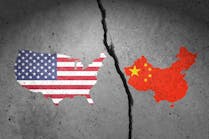COVID-19 crisis predicted to bring ‘permanent changes’ to supply chain risk management
Because of the worldwide havoc of the coronavirus, supply chains have become a crucial new focus of the global economy. Sergio Chayet, director of the Operations and Supply Chain Management MBA platform at Olin, foresees changes ahead in several areas including making workers safer and strategies to guard against future massive stresses on supply chains.
“There is a new appreciation for retail store employees, factory workers and workers in logistics and transportation, energy, health care, education, and other industries responsible for sustaining life during shutdowns,” he told Bloomberg recently.
“Just like September 11 brought permanent changes to airport and port security, it is likely this latest crisis will bring permanent changes to operations and supply chain risk management as it pertains to mitigating worker health risks and establishing contingency plans to protect them.”
Would it be better for companies to produce from geographically diverse places or from one particular region?
“Having a geographically diverse footprint and carrying excess capacity is always valuable as a real option, since it allows firms to react to a wide variety of risks (social, political, macroeconomic, etc.) by shifting production to the most convenient location on short notice with changes to the global economy. But such excess capacity is costly and must be justified by being exceeded with the real option’s value. A complementary strategy, when feasible, is having flexible contracts with supply chain partners. However, when several correlated risks happen in quick succession, partners will be unable to honor those flexible terms.”
What lessons are we now learning about supply chains?
“Over the last couple decades, driven by price and time competition, supply chains have evolved toward becoming leaner and more responsive, resulting in lower production and transportation costs. Reduced trade friction and international arbitrage opportunities in the form of wages, total cost, exchange rate, access to talent and raw materials, and other differences, has led to ever more global supply chains. Containerization, larger vessels and ports, and warehousing innovations have all contributed to lowering logistics and transportation costs. As a result, consumers have had access to unprecedented levels of product variety at low prices.
“But lean supply chains are more susceptible to disruption risk and have to rely on excess capacity or being nimble in integrating new partners into them. When the crisis started, all eyes were on China, and organizations were evaluating contingency plans to mitigate risks affecting that portion of their supply chains. In the midst of companies evaluating those contingency and reactive measures, the crisis started to become more severe in Europe and subsequently in America, rendering many of those options obsolete.”
What’s an example of a situation that may not have been considered in the past?
“The demand shocks many retailers have experienced for commodity products. Some understandable, such as face masks, hand sanitizers and general-purpose cleaners, and some less understandable, such as toilet paper.
“The familiar bullwhip effect in supply chains—driven by information and product lags, independent decisions by channel partners, and low levels of demand variability—has been overshadowed by unpredictable shocks to end-consumer demand.
“Take toilet paper: Because it’s a commodity, manufacturers have little influence on market prices. To be competitive they must control costs and usually rely on high levels of automation, low levels of labor and high-capacity utilization, with plants running 365/24/7. They can maintain high utilization only because of predicable demand, with low uncertainty and no seasonality.
“Such an unpredictable spike in demand—likely driven by a vicious cycle of panic purchases and perhaps some speculators planning to make quick profits in secondary markets—quickly depleted most of the channel’s inventory. With no excess capacity, we can expect a lag until those products are back on the shelves, which will probably be followed by more panic purchases and secondary spikes. Eventually, with so much forward buying, those supply chains will experience excess inventory.
“Interestingly, once consumers started their lockdowns, their demand for these commodities increased to supplement what they had previously used from supply chains serving the commercial market. For example, in addition to their use at home, consumers used toilet paper at offices, schools, restaurants, malls, etc. This has further strained consumer supply chains and will further delay the time it takes for manufacturers, distributors, wholesalers and retailers to replenish inventory to the new necessary levels.
“Because in several industries supply chains that serve the consumer and commercial markets are different (For instance, commercial toilet paper roles don’t fit residential toilet roll holders.), lockdowns have also created both shortages in consumer supply chains and surpluses in commercial ones. But simply shifting one to the other isn’t feasible, at least in the short term.”
Will the coronavirus change the study of supply chains?
“In supply chain risk management, planners start by identifying and assessing possible risks, which are classified according to their probability and anticipated impact. These are called foreseeable risks and are managed proactively. Relatively likely risks should be mitigated by measures designed to lower their probability or impact before they happen. Because of limited resources, less likely risks are best managed by contingency measures, which are planned ahead but only triggered after the risk happens. Remaining risks are called residual or ‘unknown unknowns’ and can only be managed reactively. The only proactive measures for those are setting aside time, resources and flexibility to be used once the risks are known.
“When major unknown unknown risks were modeled in the past, they were usually assumed to happen one at a time and independent of each other. COVID-19 turned out to be an unprecedented set of unknown unknowns all happening in rapid succession, including: A highly contagious pandemic, which quickly traveled across continents, sharp economic downturn globally, a large portion of the population under lockdown, etc.
“In the future a global pandemic of this magnitude will not only be a foreseeable event, but also will likely change how we model unknown unknowns. And depending on how likely similar pandemics are expected to be in the future, a whole slew of mitigation and contingency measures are likely to be considered.”
How long can supply chains withstand shock?
“When either demand or supply are affected, predicting how long supply chains can withstand a shock depends on the severity of the shock, the length of the disruption, and specific factors to each industry.
“What’s interesting about the current situation is that both supply and demand are being affected simultaneously. An important new factor determining the resiliency of each supply chain will be the relative changes in their supply and demand.
“A slowdown in economic activity may end up making it easier to restart some producers, in particularly those who will be able to operate with low overhead and be able to scale as demand picks up.”





